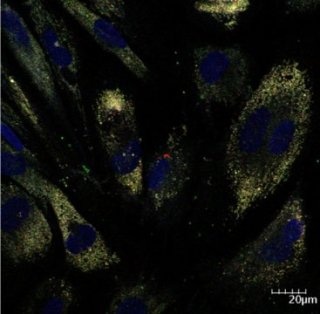May 31 2016
Brightly fluorescent nanocrystals, called quantum dots, can be used to test the delivery of drugs packaged into nanocapsules.
 Cultured fibroblasts took up both the (green) quantum dots and the (red) doxorubicin. Credit: Image courtesy of The Agency for Science, Technology and Research (A*STAR)
Cultured fibroblasts took up both the (green) quantum dots and the (red) doxorubicin. Credit: Image courtesy of The Agency for Science, Technology and Research (A*STAR)
Drug treatments are made more efficient by delivering them to specific sites in the body where they are needed. For example, specific targeting of anticancer drugs to tumour sites could reduce required doses, provide more sustained effects and minimise side effects. Such targeting is possible by encapsulating drugs in polymeric nanoparticles, or nanocapsules, that transport them through the body to their targets. However, the properties of various nanocapsules and of drugs can vary, and testing the effectiveness of different systems can be difficult.
Some drugs are inherently fluorescent and can therefore be easily visualised, making their transport and targeting easy to track. However, many drugs cannot be visualised in this way, making it impossible to know whether they are delivered to targets appropriately or efficiently. Researchers at the Agency for Science, Technology and Research (A*STAR) Institute of Materials Research and Engineering aimed to develop an effective strategy for assessing new delivery systems.
The team first demonstrated that the uptake of a drug by target cells depends on the properties of the nanocapsules rather than the properties of the drug. They packaged the anticancer drug doxorubicin -- which is inherently fluorescent and exists in water-soluble and water-insoluble forms -- into nanocapsules, and found that cultured cancer cells took up both forms of the drug with the same efficiency.
The researchers then showed that when quantum dots -- semiconductor nanocrystals that glow when hit by light -- were put in nanocapsules in place of doxorubicin, they were delivered to several different types of cancer cells the same way as the drug. The scientists concluded that quantum dots could be used in place of both water-soluble and water-insoluble drugs to test the feasibility and effectiveness of different polymeric nanoparticles as drug carriers.
Having validated their technique, the researchers now hope to qualitatively and quantitatively evaluate possible polymeric nanoparticle systems, thereby enabling improvements in drug delivery.
Story Source:
The above post is reprinted from materials provided by The Agency for Science, Technology and Research (A*STAR). Note: Materials may be edited for content and length.